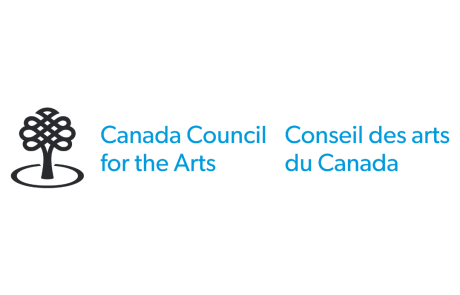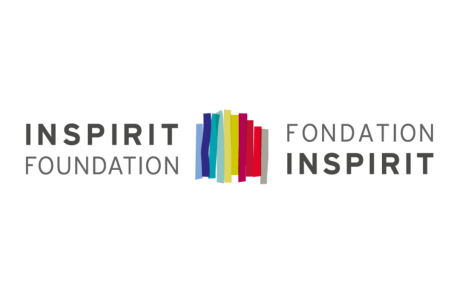Podcast with Tatiana Lomahaftewa-Singer, curator of 50/50 Fifty Artists / Fifty Years
by Gloria Bell
 50/50 exhibition, MoCNA, Photo Credit: G Bell
50/50 exhibition, MoCNA, Photo Credit: G Bell

Michelle McGeough artwork, Photo Credit: G Bell
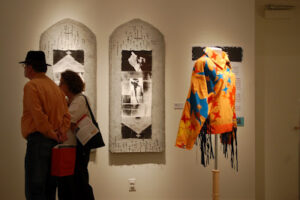
50/50 exhibition, MoCNA, Photo Credit: G Bell
Tatiana Lomahaftewa-Singer is the curator of collections at the Museum of Contemporary Native Arts in Santa Fe, New Mexico. She took a few moments out of her busy schedule to speak with me about her exhibition 50/50 Fifty Artists /Fifty Years.
What inspired you to create this exhibition?
It’s the 50th anniversary of the Institute of American Indian Arts (IAIA) this year, and I was asked to create an exhibition. This exhibition is part of the celebration. I wanted to select works that directly spoke to the history of IAIA and to also celebrate the many artists that have studied here. I decided to pick 50 artists over the five decades of the IAIA. At first it was overwhelming. In the collection we have about 70 – 80 percent of the students represented from alumni of 3400. How am I only going to pick 50 people to represent the institute? Just to be equal, I thought I would go ahead and pick 10 artists per decade and that would equal it out. The works are student works, not faculty or staff. I wanted to tie it back into the institute; it shows a reflection of the type of art that was being produced, a reflection back on the institute.
The IAIA opened its doors in October of 1962. There have been many transformations of the school.
It started off as an art-school, high school for Native Americans. Over the mid 70s it was a middle college and they phased out the high school program by 1979. In the 90s, they started working on a BFA program and introduced it in 2001. Now there is a four year degree program.
While all the works are mature, you can see a difference between the different decades (styles, approaches). The first couple of decades were purely educational. For instance, because of the dynamic student body, the studios were dynamic. For example, you had an Alaskan student sitting next to a student from the North East or North West, being inspired by these cultural differences. You also had the Native faculty guiding them to new expressions. When they eliminated the high school program, you saw a little more individualism, especially through the use of different mediums. Now, in this third phase of IAIA, you really see a reflection of what is going on around them, the digital age.
What selection process did you use to pick out 50 pieces from the collection?
50 artists were selected. This was a difficult decision. For some decades we have a lot of works, others less, I chose 10 artists per decade (student works). All of the works in this exhibition were created while students were at the IAIA, which opened in 1962.
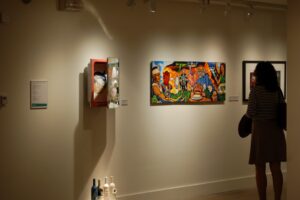 50/50 exhibition, MoCNA, Photo Credit: G Bell
50/50 exhibition, MoCNA, Photo Credit: G Bell
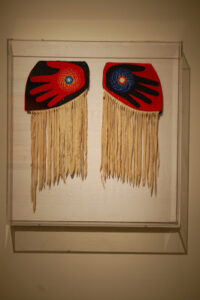
50/50 exhibition, MoCNA, Photo Credit: G Bell
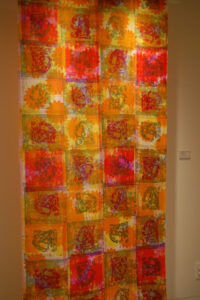
50/50 exhibition, MoCNA, Photo Credit: G Bell
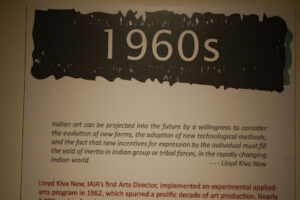 50/50 exhibition, MoCNA, Photo Credit: G Bell
50/50 exhibition, MoCNA, Photo Credit: G Bell
Could you tell me about the IAIA’s collection? (Institute of American Indian Arts?)
The IAIA’s collection is entrusted to the Museum of Contemporary Native Arts (the museum of IAIA) . There are approximately 7500 works of art. Because collecting practices started at the beginning, it is heavy in the history of the school. We also collected cultural art forms from prominent Native artists. We have an almost comprehensive collection of contemporary Native art.
Can you tell me about the digital installation that will be part of the exhibition from the IAIA New Media Arts Department?
This project is still in the works. I’m working with Carlos Panato to develop it. While we don’t know what the future is, we want to communicate the idea that the strength of this program will continue to be here and develop. The digital format will be silhouette images of actual students. We feel strongly that the students will carry us into the future. They will be the next generation of the art movement.
What are the most significant challenges that curators face?
Making that decision of the works and the artists, who best represents was tough. It was torturous to eliminate people. I started out with 400 – 500 people and had to eliminate down to 50. To show the diversity of the school was also another challenge.
I really wanted to make sure that women were represented as well. There is a lot of criticism that we don’t show women enough. I made a conscious effort to make sure women were represented. The funny thing was that the first couple of decades it was difficult to find women artists, but then it changed in the 90s, when there were more women than men. Selecting artists and then artworks were the most difficult processes. There were many logistical issues to consider as well (the strength of the piece, the stability of the piece, a limited budget for conservation).
Another curatorial decision I made was I wanted to mix it up with less-seen works. There are some old friends (1000 works that have been seen a lot). I wanted to show some old with new.
The exhibition is heavy in two-dimensional works (paintings, graphic works, sculpture). I only picked one jeweler.
Another component is that there are audio readings/recordings by some of the writers that have come out of the institute including Elizabeth Woody, Sarah Otiz, Rosemary Diaz, Bruce King. The audio gives another element, another way of experiencing the show, because they are strong works, they take you away. They are read by both men and women writers. The creative writing program has been such a strong part of the school.
Does this exhibition co-incide with any similar exhibitions during Indian Art Market?
The exhibition opens August 16th, along with four other solo exhibitions at Museum of Contemporary Native Arts (MOCNA).
Does IAIA have an active acquisition practice?
We have an acquisitions committee, we’ve just re-engaged it. We meet quarterly and review proposals. From the very beginning there has been an administrative effort to collect student works. We have works from as early as 1962, the very first semester, before we had the museum. The museum was opened in 1972. We are still learning about the whole purpose behind the collecting practices. It was a collective idea between the director (Lloyd Kiva New) , James McGraff, and the instructors (Alan Houser and others). We think that part of the motive to collect was to use it as a development tool to promote the institution. They sent works out as mini exhibitions throughout the country and abroad. When the museum opened in 1972, the first decade was heavily represented. This was called the honors collection. This practice continued, the collecting was pretty heavy in the 1970s and 80s, lessened in the 90s. In the last decade, we didn’t collect as much because we had maxed our collection storage. The renovation of the museum in 2005 alleviated this pressure. Now that we have a new storage facility we can grow our collection.
We are looking towards expanding our rich resources, creating a research center for contemporary art (with the collection itself, institutional archives, special collections library).
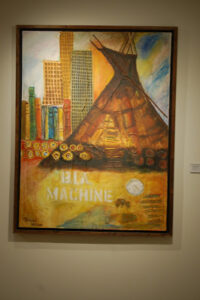 50/50 exhibition, MoCNA, Photo Credit: G Bell
50/50 exhibition, MoCNA, Photo Credit: G Bell
Is there anything else you would like to add?
I’m currently writing an essay for the exhibition catalog with Rosemary Diaz, that will also feature the exhibition Under the Influence: Iroquois Artists at IAIA 1962 – 2012 (curated by Ryan Rice and Colette Lemmon). This catalog will be available in the fall. The exhibition has a four month run, open until December 31rst.
Also I wanted to mention, throughout the exhibition, I’m including quotes by Llody Kiva New , the first arts director of IAIA director, professor emeritus, and one of the visionaries of the school. I wanted to pay honour to him. We are celebrating our 40th anniversary for the museum, the institute is celebrating its 50th! The museum has maintained and directed this collection for forty years.
Thank you to Tatiana Lomahaftewa-Singer and the Museum of Contemporary Native Arts for their cooperation.
This interview was created as part of the curator profiles series for the Aboriginal Curatorial Collective (ACC). To learn more about the ACC, see the facebook page.
Listen to the Podcast with Tatiana Lomahaftewa-Singer here:
 Gloria Bell’s research and teaching examines visual culture focusing on Indigenous arts of the Americas, primarily from the nineteenth century through to contemporary manifestations. Currently, her research focuses on exhibition histories of First Nations, Métis and Inuit arts in the early twentieth century in Italy, Global Indigenous studies, decolonizing and anti-colonial methodologies, materiality studies, global histories of body art, and the importance of art as living history.
Gloria Bell’s research and teaching examines visual culture focusing on Indigenous arts of the Americas, primarily from the nineteenth century through to contemporary manifestations. Currently, her research focuses on exhibition histories of First Nations, Métis and Inuit arts in the early twentieth century in Italy, Global Indigenous studies, decolonizing and anti-colonial methodologies, materiality studies, global histories of body art, and the importance of art as living history.

